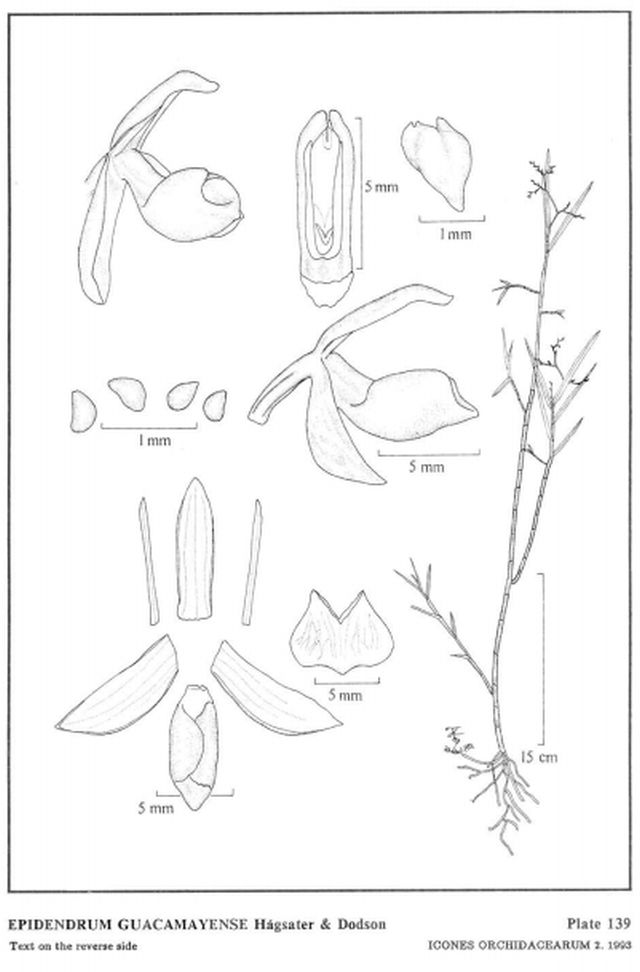

Epidendrum guacamayense Hágsater & Dodson 1993 GROUP Elleanthoides SUBGROUP Guacamayense
TYPE Drawing by © Jimenez, Hágsater & E.Santiago and The AMO Herbario Website





Common Name or Meaning The Cordillera de Guacamaya Epidendrum [mountain range in central Ecuador]
Flower Size .08" [2 mm]
Found in Colombia? and Ecuador in wet cloud forests at elevations around 1850 to 2600 meters as a small sized, cool to cold growing lithophyte with erect, straight, terete, cane-like, branched when mature, branches smaller stems carrying a few, towards the apex of the stems, deciduous, narrowly lanceolate, acuminate, grasslike leaves that blooms in the winter through spring on a terminal, from the main stem and the branches, occuring only once, 1.6 to 5.2" [4 to 13 cm] long, arcuate, paniculate, rachis zigzag, successively single, several flowered inflorescence with yellowish green flowers that barely open with bronze colored sepals.
"Epidendrum guacamayense belongs to the GROUP Elleanthoides SUBGROUP Guacamayense characterized by the branching stems, verrucose sheaths, long, narrow, grassy leaves, and a filiform peduncle. The species is recognized by the erect, branching stems with grass-like, narrow leaves, the apical arcuate inflorescence with very thin peduncle, and the successive, fleshy flowers with the lip completely embracing the column and ending in an obtuse point. Epidendrum bryophilum also has very narrow leaves, but has a racemose inflorescence, with the lateral lobes of the lip embracing the column without overlapping the wide nectary. Epidendrum rubioi Hágsater & Dodson is closely related but has scandent, branching stems with grass-like, narrow leaves with the margins erose-dentate, the apical nutant raceme with 2 to 3 successive, lemon green, odorless flowers, and the lip completely embracing the column and ending in an abruptly apex. Epidendrum insignificans Hágsater & Dodson has a sturdier habit overall, a nearly straight column which is partially exposed by the lip, linear-lanceolate petals, and a differently-shaped nectary; the inflorescence produces new racemes through the years, the peduncle being thin but not filiform." Hagsater etal 1993 and 2007
References W3 Tropicos, Kew Monocot list , IPNI ; *Icones Orchidacearum Peruviarum Plate 460 Bennett & Christenson 1998 drawing fide; Icones Orchidacearum 2 Plate 139 Hagsater & Salazar 1993 drawing fide; Icones Orchidacearum 2 Plate 148 Hagsater & Salazar 1993 drawing fide; Icones Orchidacearum 2 Plate 173 Hagsater & Dodson 1993 see recognition section; Icones Orchidacearum 2 Plate 184 Hagsater & Dodson 1993 see recognition section; Icones Orchidacearum 4 Plate 423 Hagsater 2001 see recognition section; Icones Orchidacearum 4 Plate 461 Hagsater 2001 see recognition section; Icones Orchidacearum 4 Plate 483 Hagsater 2001 see recognition section; Icones Orchidacearum 4 plate 491 Hagsater & Sanchez 2001 see recognition section; Icones Orchidacearum 4 plate 495 Hagsater & Sanchez 2001 see recognition section; Icones Orchidacearum 7 Plate 718 Hagsater and Sanchez 2004 see recognition section; Icones Orchidacearum 7 Plate 735 Hagsater and Sanchez 2004 see recognition section; Icones Orchidacearum 7 Plate 740 Hagsater and Sanchez 2004 see recognition section; Icones Orchidacearum 7 Plate 775 Hagsater and Sanchez 2004 see recognition section; Icones Orchidacearum 7 Plate 789 Hagsater and Sanchez 2004 see recognition section; Icones Orchidacearum Vol 8 Plate 830 Hagsater & Sanchez 2006 see recognition section; Icones Orchidacearum 9 Plate 961 Hagsater 2007 see recognition section; Icones Orchidacearum 11 Plate 1187 Hagsater 2008 see recognition section; Icones Orchidacearum 12 Plate 1220 Hagsater 2009 see recognition section; Icones Orchidacearum 13 Plate 1387 Hagsater & Santiago 2010 See recognition section; Orquideas, Tesoro de Colombia Vol 2 Ortiz & Uribe 2017 Photo good;
--------------------------------------------------------------------------------------------------------------------------